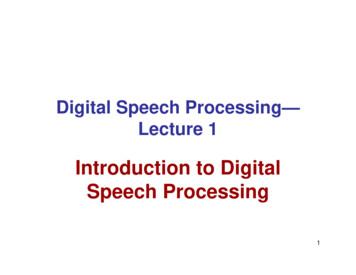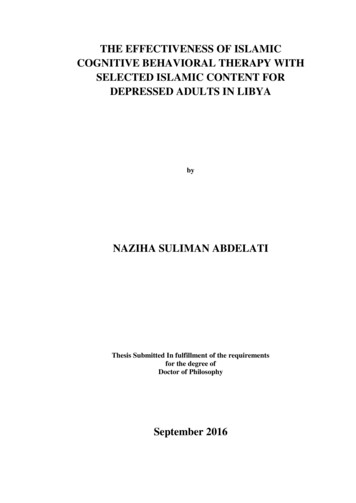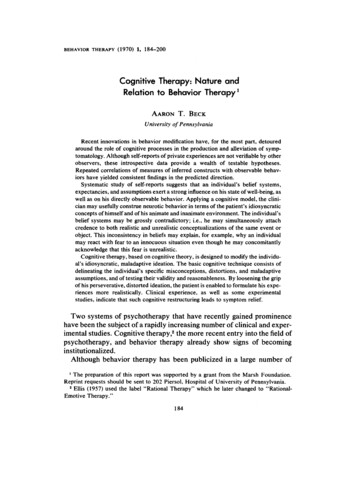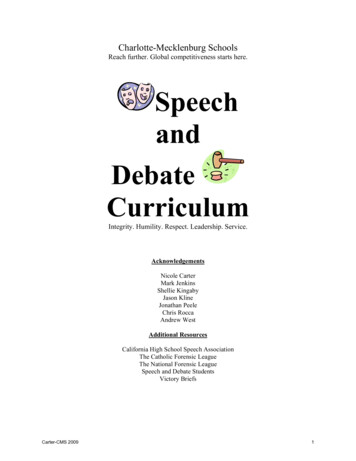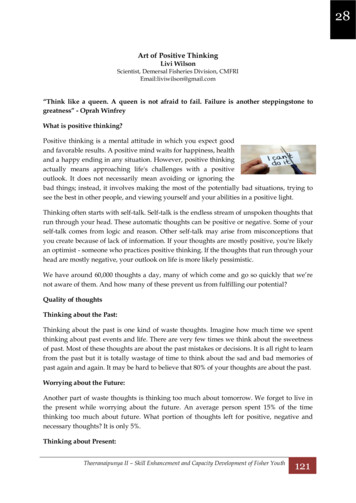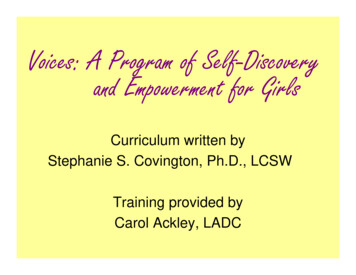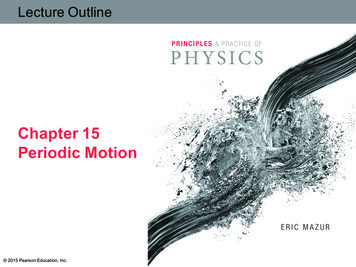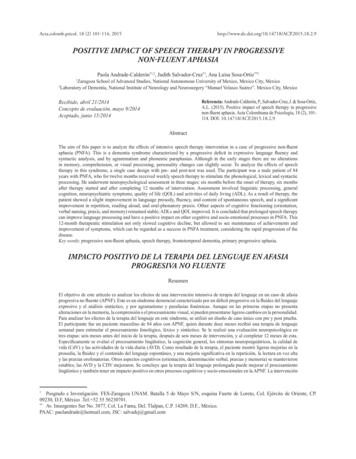
Transcription
Acta.colomb.psicol. 18 (2) 101-114, POSITIVE IMPACT OF SPEECH THERAPY IN PROGRESSIVENON-FLUENT APHASIAPaola Andrade-Calderón*1,2, Judith Salvador-Cruz*1, Ana Luisa Sosa-Ortiz**2Zaragoza School of Advanced Studies, National Autonomous University of Mexico, Mexico City, MexicoLaboratory of Dementia, National Institute of Neurology and Neurosurgery “Manuel Velasco Suárez”. Mexico City, Mexico12Referencia: Andrade-Calderón, P., Salvador-Cruz, J. & Sosa-Ortiz,A.L. (2015). Positive impact of speech therapy in progressivenon-fluent aphasia. Acta Colombiana de Psicología, 18 (2), 101114. DOI: 10.14718/ACP.2015.18.2.9Recibido, abril 21/2014Concepto de evaluación, mayo 9/2014Aceptado, junio 15/2014AbstractThe aim of this paper is to analyze the effects of intensive speech therapy intervention in a case of progressive non-fluentaphasia (PNFA). This is a dementia syndrome characterized by a progressive deficit in expressive language fluency andsyntactic analysis, and by agrammatism and phonemic paraphasias. Although in the early stages there are no alterationsin memory, comprehension, or visual processing, personality changes can slightly occur. To analyze the effects of speechtherapy in this syndrome, a single case design with pre- and post-test was used. The participant was a male patient of 84years with PNFA, who for twelve months received weekly speech therapy to stimulate the phonological, lexical and syntacticprocessing. He underwent neuropsychological assessment in three stages: six months before the onset of therapy, six monthsafter therapy started and after completing 12 months of intervention. Assessment involved linguistic processing, generalcognition, neuropsychiatric symptoms, quality of life (QOL) and activities of daily living (ADL). As a result of therapy, thepatient showed a slight improvement in language prosody, fluency, and content of spontaneous speech, and a significantimprovement in repetition, reading aloud, and oral-phonatory praxis. Other aspects of cognitive functioning (orientation,verbal naming, praxis, and memory) remained stable; ADLs and QoL improved. It is concluded that prolonged speech therapycan improve language processing and have a positive impact on other cognitive and socio-emotional processes in PNFA. This12-month therapeutic stimulation not only slowed cognitive decline, but allowed to see maintenance of achievements andimprovement of symptoms, which can be regarded as a success in PNFA treatment, considering the rapid progression of thedisease.Key words: progressive non-fluent aphasia, speech therapy, frontotemporal dementia, primary progressive aphasia.IMPACTO POSITIVO DE LA TERAPIA DEL LENGUAJE EN AFASIAPROGRESIVA NO FLUENTEResumenEl objetivo de este artículo es analizar los efectos de una intervención intensiva de terapia del lenguaje en un caso de afasiaprogresiva no fluente (APNF). Este es un síndrome demencial caracterizado por un déficit progresivo en la fluidez del lenguajeexpresivo y el análisis sintáctico, y por agramatismo y parafasias fonémicas. Aunque en las primeras etapas no presentaalteraciones en la memoria, la comprensión o el procesamiento visual, sí pueden presentarse ligeros cambios en la personalidad.Para analizar los efectos de la terapia del lenguaje en este síndrome, se utilizó un diseño de caso único con pre y post prueba.El participante fue un paciente masculino de 84 años con APNF, quien durante doce meses recibió una terapia de lenguajesemanal para estimular el procesamiento fonológico, léxico y sintáctico. Se le realizó una evaluación neuropsicológica entres etapas: seis meses antes del inicio de la terapia, después de seis meses de intervención, y al completar 12 meses de esta.Específicamente se evaluó el procesamiento lingüístico, la cognición general, los síntomas neuropsiquiátricos, la calidad devida (CdV) y las actividades de la vida diaria (AVD). Como resultado de la terapia, el paciente mostró ligeras mejorías en laprosodia, la fluidez y el contenido del lenguaje espontáneo, y una mejoría significativa en la repetición, la lectura en voz altay las praxias orofonatorias. Otros aspectos cognitivos (orientación, denominación verbal, praxias y memoria) se mantuvieronestables; las AVD y la CdV mejoraron. Se concluye que la terapia del lenguaje prolongada puede mejorar el procesamientolingüístico y también tener un impacto positivo en otros procesos cognitivos y socio-emocionales en la APNF. La intervenciónPosgrado e Investigación. FES-Zaragoza UNAM. Batalla 5 de Mayo S/N, esquina Fuerte de Loreto, Col. Ejército de Oriente, CP.09230, D.F, México .Tel: 52 55 56230701.**Av. Insurgentes Sur No. 3877, Col. La Fama, Del. Tlalpan, C.P. 14269, D.F., México.PAAC: paolandrade@hotmail.com, JSC: salvadcj@gmail.com*
102 Paola Andrade-Calderón, Judith Salvador-Cruz, Ana Luisa Sosa-Ortizno solo disminuyó la velocidad del deterioro cognitivo, sino que permitió ver el mantenimiento de los logros y la mejoría delos síntomas, lo cual es un éxito en el tratamiento de la APNF, debido a su rápida progresiónPalabras clave: afasia progresiva no fluente; terapia del habla, demencia frontotemporal, afasia progresiva primaria.IMPACTO POSITIVO DA TERAPIA DA LINGUAGEM EM AFASIAPROGRESSIVA NÃO FLUENTEResumoO objetivo deste artigo é analisar os efeitos de uma intervenção intensiva de terapia da linguagem em um caso de afasiaprogressiva não fluente (APNF). Esta é uma síndrome demencial caracterizada por um déficit progressivo na fluência dalinguagem expressiva e da análise sintática, e por agramatismo e parafasias fonêmicas. Ainda que nas primeiras etapasnão presenta alterações na memória, na compreensão ou no processamento visual, podem aparecer pequenas mudanças napersonalidade. Para analisar os efeitos da terapia da linguagem nesta síndrome, utilizou-se um desenho de caso único comtestes antes e depois. O participante foi um paciente masculino de 84 anos com APNF, que durante doze meses recebeuuma terapia de linguagem semanal para estimular o processamento fonológico, léxico e sintático. Realizou-se uma avaliaçãoneuropsicológica em três etapas: seis meses antes do início da terapia, depois de seis meses de intervenção, e ao completar12 meses desta. Avaliou-se especificamente o processamento linguístico, a cognição geral, os sintomas neuropsiquiátricos,a qualidade de vida (QdV) e as atividades da vida diária (AVD). Como resultado da terapia, o paciente mostrou pequenasmelhorias na prosódia, na fluência e no conteúdo da linguagem espontânea, e uma melhoria significativa na repetição, na leituraem voz alta e nas praxias orofonatórias. Outros aspectos cognitivos (orientação, denominação verbal, praxias e memória)mantiveram-se estáveis; as AVD e a QdV melhoraram. Conclui-se que a terapia da linguagem prolongada pode melhorar oprocessamento linguístico e também ter um impacto positivo em outros processos cognitivos e sócio emocionais na APNF. Aintervenção diminuiu não somente a velocidade da deterioração cognitiva, senão que permitiu ver a manutenção dos êxitos e amelhoria dos sintomas, o que representa um sucesso no tratamento da APNF, devido a sua rápida progressãoPalavras chave: afasia progressiva não fluente; terapia da fala, demência fronto temporal, afasia progressiva primária.INTRODUCTIONFrontotemporal dementia (FTD) is a group of clinicalsyndromes associated with the degeneration of frontal andanterior temporal cortical regions (Neary et al., 1998).Primary progressive aphasia (PPA), a subtype of FTD, ischaracterized by different patterns of language impairmentdistinguished by three clinical phenotypes: semantic, logopenic, and non-fluent/agrammatic variants. Patients withthe semantic variant show abnormalities in single wordcomprehension and naming, with relatively preservedgrammar and fluency; patients with the logopenic varianthave intermittent word-finding hesitations, phonemic paraphasias, and impaired repetition (Gorno-Tempini et al.,2011). The non-fluent/agrammatic variant, also known asprogressive non-fluent aphasia (PNFA) is characterizedby a progressive deficit in expressive language fluency,agrammatism, and phonemic paraphasias. Although in theearly stages there are no alterations in memory, comprehension, or visual processing, slight personality changescan occur; there is a deficit of syntactic analysis at theonset of illness (Mesulam et al., 2003).The speech feature referred to as speech apraxia is animpairment in the motor planning and sequencing of themovements, which leads to stuttering over the initial con-sonant of a word, hesitation in mid-word, and a breakdownof normal speech rhythm (Gorno-Tempini et al., 2004). InPNFA, the grammar used is often simplified, with occasionalinflectional errors (Clark et al., 2005; Graham et al., 2004;Wang et al., 2005). Although having clinically normalepisodic memory, affected patients show poor executionon verbal memory tests (Neary et al., 1998; Hodges et al.,1999; Graham et al., 2003). For such patients, visuo-spacialabilities are well preserved (Graham et al., 2003; Perry &Hodges, 2000), but executive functions are usually impaired, especially in sorting and digit-span tasks (Hodges etal., 2000; Nestor et al., 2003). The diagnosis of PNFA isusually made when other cognitive processes are foundto be relatively preserved, with language being the onlyimpaired area, at least during the first two years of thedisease (Mesulam, 2003). As the illness advances, oralexpression is reduced and comprehension is progressivelyaltered. There is significant decline in the number andlength of words produced; patients eventually becomemonosyllabic, communicate only with unintelligiblegrunts, and in advanced stages, may become mute(Gorno-Tempini et al., 2004).Neuroimaging studies of PNFA patients (Nestor et al.,2003) have shown atrophy in the left posterior area of thefrontal lobe, a region associated with speech production
Speech therapyand the coordination and planning of articulation movements. The alterations were thought to be localized inthe left hemisphere, mainly in the pars opercularis of theinferior frontal gyrus (Brodmann area (BA) 44), uppertemporal pole (BA 38), basal ganglia (lenticular nucleus),and middle frontal gyrus (BA 8/9) (Friederici & Kotz,2003). In advanced cases in which mutism occurs, thealterations were found to extend into subcortical regions(Gorno-Tempini et al., 2006, Neary et al., 1998). Fluencydeficits have usually been associated with atrophy in theposterior inferior and middle frontal gyrus, whereas grammatical processing is associated with more widespreadatrophy, including other regions of the inferior frontal gyrusand supramarginal gyrus (Rogalski et al., 2011).Unlike people with Alzheimer Disease (AD), patientswith PNFA often become aware of the problem earlierthan family members or other people close to themdo, with difficulties arising in linguistic demandingsituations. Such patients do not usually complain ofmemory disturbances other than in the verbal domain;they are not disorientated and their activities of dailyliving (ADLs) typically remain unaffected; significantpersonality changes may occur in advanced stages of thedisease (Gorno-Tempini et al., 2004; Neary et al., 1998).This type of aphasia is caused by a neurodegenerative disease that is second only to AD in prevalence andwhich accounts for 10–15% of untreatable dementias(Boeve, 2003), It is considered a dementia not only dueto the gradual cognitive impairment that compromisesthe development of the patient’s ADLs related to communication, but also due to additional manifestations,such as depressive symptoms, which may occur in reaction to these deficits, affected ADLs, or the shame andfrustration caused by the inability to communicate andinteract, which can lead to social deterioration (Raymeret al., 2001). From reports on prognosis in PNFA (Rogers & Alarcon, 1999; Hodges et al., 2003), the mediansurvival is 6.8 years; therefore, a rapid progression ofthe disease is expected.Intervention experienceIt is known that patients with PNFA may benefitfrom language stimulation, such as that provided bythe strategies used in non-progressive language disorders(Berndt, Mitchum & Haendiges, 1996; Greenwald et al.,1995; Kiran & Thompson, 2002; Raymer & Ellsworth,2002). To date, most treatments have been implementedwith the aim of improving naming, a deficit that is thecharacteristic symptom in the early stages. Researchershave used both visual stimulus (Laurence et al., 2002;103Rapp & Glucroft, 2009) and computerized approaches(Jokel et al., 2009) to stimulate the specific naming ofobjects, both orally and in writing. Others have focusedon retrieval of nouns, adjectives, and verbs by improvingthe knowledge of semantic attributes through gesture(Schneider, Thompson & Luhring, 1996) or by stimulatingauditory-phonological processing (Koenig-Bruhin et al.,2005; Louis et al., 2001).Farrajota et al. (2012) reported that, through a combination of different exercises (such as picture naming,describing actions depicted in pictures, comprehendingcomplex auditory-verbal exercises, reading and writing,facilitating expression of feelings and opinions, and enhancing conversational skills), speech and language therapycan improve naming ability and verbal fluency for patientswith PNFA. By combining behavioral and pharmacological treatment (dextroamphetamine, a psychostimulantand amphetamine stereoisomer), McNeil et al. (1995)assessed the efficacy of an intervention for a person withPPA (specifically to treat dysnomia). They found that theimprovement in performance and word-finding abilitywas more evident when the patient had received bothtreatments, thus highlighting the importance of havinga combined pharmacological and non-pharmacologicaltreatment for an efficient intervention.Other studies applying behavioral treatment reportedthat, immediately after treatment, improvements wereseen in worked material (Farrajota et al., 2012; Jokel et al.,2009; Koenig-Bruhin et al., 2005; Laurence et al., 2002;Louis et al., 2001; McNeil et al., 1995; Rapp & Glucroft,2009; Schneider et al., 1996) and in generalization (Louiset al., 2001; McNeil et al., 1995; Schneider et al., 1996). Inthese studies, the intervention period was two weeks to onemonth (Laurence et al., 2002), one to three months (Jokelet al., 2009; Laurence et al., 2002; Louis et al., 2001; Rapp& Glucroft, 2009), or five to eleven months (Farrajota etal., 2012; Koenig-Bruhin et al., 2005; McNeil et al., 1995;Schneider et al., 1996). It was found that, without practice nor intervention, the benefits disappeared after onemonth (Jokel et al., 2009), three months (McNeil et al.,1995; Schneider et al., 1996), or six months (Laurence etal., 2002; Rapp & Glucroft, 2009). The patients treated inthese studies were in mild-to-moderate stages of impairment. Because most of the studies published were focusedon stimulating a single linguistic process (i.e., naming)(Jokel et al., 2009; Koenig-Bruhin et al., 2005; Laurenceet al., 2002; Louis et al., 2001; McNeil et al., 1995; Rapp& Glucroft, 2009; Schneider et al., 1996), this may be thereason for the positive results in improving naming, withlittle or no generalization, improvement, or maintenance
104Paola Andrade-Calderón, Judith Salvador-Cruz, Ana Luisa Sosa-Ortizafter intervention of unworked material (Koenig-Bruhin etal., 2005). This is an important limitation of the interventiondesign that was used in these studies.The presence and progression of all the changes incognition and behavior in a patient affect the patient’sfamily environment. Because caregivers have to understand, cope with and accept the symptoms (Raymer et al.,2001) this can become a critical problem. Caregivers ofdementia patients often experience high levels of stress,overload, anxiety, and other negative impacts on boththe emotional and physical levels (Riedijk, et al., 2006;Mioshi et al., 2009).Evidence from these studies suggests that properlydesigned interventions may have positive effects on language functioning; however, there are some limitations—inparticular, the duration of intervention, as little is knownabout whether a patient receiving speech therapy for morethan six months can maintain and/or improve languageperformance. It is also unknown if speech therapy canhave a positive effect on other non-linguistic aspects,such as general cognition, quality of life (QoL), ADLs,mood, and family environment.The characteristics of the aforementioned interventionsshow the need for and importance of the design, implementation, and dissemination of systematic speech therapyprograms for PNFA patients, that are not only ecologicallyvalid and can be replicated, but that can also be used toassess the benefit, maintenance, and/or generalization ofthe intervention. Such programs would contribute to acomprehensive treatment that could improve the QoL ofpatients and their families. It is of interest to determine ifa program that stimulates various processes of linguisticfunctioning is able to produce short and long-term changes(maintenance or improvement) not only at the linguisticfunctioning level, but also in the QoL and ADLs of thepatient, while also improving the family environment. Wehypothesize that, through the use of such a program,performance in language processing, general cognition,and socio-emotional areas would improve and that thisimprovement would be temporarily stable. In order todetermine if speech therapy has the potential to positivelyimpact the linguistic performance and the non-linguisticaspects in a patient with PNFA, an intervention programwas developed that took into account the linguistic processing model of Levelt, Roeloft & Meyer (1999), whichproposes the interaction and independence of variouslinguistic subsystems, with expressive language arisingfrom the connection between modules that store specificlanguage information. Thus, a program that combinedstimulation strategies related to different components forlanguage processing (phonological, lexical, and syntactic)was elaborated. This 12-month speech therapy program wasadministered to a patient with PNFA to determine whetherthis kind of program would improve the patient’s languageprocessing, general cognition, neuropsychiatric symptoms(NPS), QoL and ADLs and would also benefit his family.METHODParticipantJM is an 84-year-old, right-handed, male patient whohas worked as a merchandiser. He has 12 years of schooling; his first and only language is Spanish. In 2006, JMcomplained of increasing word-finding difficulties, whichevolved into non-fluent discourse. In 2011, JM attendedthe National Institute of Neurology and Neurosurgery“Manuel Velasco Suárez” (NINN) in Mexico City whereexploration was initiated and the necessary studies wereperformed to determine his general medical condition.In February 2011, magnetic resonance imaging showedreduced cortical and subcortical cerebral and cerebellarvolume; the cortical atrophy was predominantly left posterior fronto-insular region. Neurological status was normal.JM’s language continued to worsen; in May 2011, JM wasdiagnosed with PNFA by the clinicians of the Laboratoryof Dementia at NINN, following the criteria proposedby Gorno-Tempini et al. (2011).JM started pharmacological treatment, consisting ofcitalopram and memantine (20 mg each per day). Thistreatment was continued during the one-year courseof the speech therapy that he received at the DementiaClinic (NINN).DesignAt NINN, over a 12-month period (October 2011 toNovember 2012), JM received weekly speech therapyfrom a neuropsychologist (PAAC). This therapy stimulated phonological, lexical, and syntactic processing andwas used in conjunction with daily homework. Examination of the therapy effects was documented by applyinga single-subject pre-post test design. Written informedpatient consent was obtained. The protocol adheres tothe Declaration of Helsinki (2008) and the regulationsof the General Clinical Research Health Law of Mexico(1983). The Bioethics Committee of the NINN evaluatedand accepted this clinical research protocol.AssessmentA battery of tests was administered to JM, which assessedthe patient’s language and general cognitive functioning,NPS, QoL, and ADLs. The emotional state, QoL, and
Speech therapyburden of the primary caregiver (JM’s daughter) were alsoassessed through the application of three scales. The sameinstruments (see Materials section) were used at threestages: pre-intervention assessment (basal: October2011); at six months of intervention (intermediate: April2012); and after receiving twelve months of therapy (final:November 2012). Implementation and assessment of thespeech therapy were conducted by the first author ofthis paper (PAAC).MaterialsThe neuropsychological assessment battery appliedcovered general cognitive functioning, with emphasis onthe following measures:General cognitive functioning: Mini-Mental State Examination, MMSE (Folstein, Folstein & McHugh, 1975);Neuropsychological Integrated Exploration Program“Test Barcelona”. Abbreviated Version (Villa, 2006);Informant Questionnaire on Cognitive Decline in the Elderlyand IQCODE (Jorm & Korten, 1988; Morales et al., 1995).Verbal learning: Auditory Verbal Learning Test, “TestBarcelona” Alfa Version (Peña-Casanova, 2005).Verbal comprehension: Token Test (De Renzi & Faglioni, 1978).Visuo-spatial memory: Rey-Osterrieth Complex FigureTest (Cortés, Galindo & Salvador, 1996; Rey, 2003).Executive functioning: Trail Making Test (Partington &Leiter, 1949); Stroop Color and Word Test (Golden, 1976).Patient neuropsychiatric symptoms: NeuropsychiatricInventory Questionnaire, NPI-Q (Cummings et al., 1994);Yesavage Geriatric Depression Scale (Yesavage et al.,1982; Baker & Espino, 1997) and Beck Anxiety Inventory(Beck et al., 1988; Robles et al., 2001).Patient functionality and QoL: Barthel Scale (Collin etal., 1988); Pfeffer functional activities questionnaire (PFAQ;Pfeffer et al., 1984); Quality of life for the person withdementia questionnaire (DEMQOL) (Smith et al., 2007)and Quality of Life Questionnaire (DEMQOL-answeredby the patient’s family) (Smith et al., 2007).Emotional state of the patient’s primary caregiver:Self-reporting questionnaire (SRQ) (Harding, et al., 1980;Mari & Williams, 1985).Quality of life and patient’s primary caregiver andoverload: The World Health Organization Quality of LifeScale (WHOQOL-BREF) (The WHOQOL Group, 1998)and Zarit Caregiver burden scale (Zarit, Reever & BachPeterson, 1980).For the implementation of the neuropsychological testbattery, three sessions of 60 minutes each, one per week,were required in each of the three instances of assess-105ment. The questionnaires were answered by the patientat his residence; the same was true for the questionnairesanswered by the primary caregiver. Questionnaires werereturned by JM and his family in the second session ofeach of the three instances of evaluation.InterventionBased on the pre-intervention testing (see Results section), a program was designed for working on JM’s languagedeficits, structuring an intervention that combined exercisesto stimulate phonological, lexical and syntactic processing(oral and writing). Writing exercises were included becauseof the benefit reported in patients (Rodríguez & Baquero,2011). In a briefing session with JM and his family beforethe start of the intervention, the characteristics of PNFA, itscauses, course, and prognosis were explained to them; thetreatment goals and the importance of family support in theprocess were also discussed. In this session, JM, his family, and the speech therapist (PAAC) selected four topics(food, home, body and animals) that all agreed were themost important to JM’s ADLs; for each of these topics, alist consisting of 20 stimuli that would exercise lexical,phonological and syntactic stimulation was developed.To structure the sentences in each list, four verbs (want,eat, take and give) were selected, since according to JMand his family, these were the most frequently used.Over a 12-month period, in addition to attending 50individual sessions (60 min. each) with PAAC, whichwere held at the Laboratory of Dementia, JM also did dailyhomework, which consisted of repeating the exercisesperformed at the clinic. In the first stage (months 1–6), thefirst 25 sessions consisted of articulation exercises (threesessions), phonological stimulation (six sessions), lexicalstimulation (visual and verbal stimulus: eight sessions), andsyntactic processing (eight sessions). In the second stage(months 7–12), JM continued with the same sequenceof exercises, but the difficulty of the tasks was graduallyincreased. The sequence of sessions and some examplesof the tasks performed are described below.Strengthening of pulmonary ventilationEvery session started with ten minutes of exercisesto strengthen pulmonary ventilation; for example, theprolonged emission of vowel sounds with exaggeratedoral-facial movements.Stimulation of articulatory releaseIn all the sessions, exercises focused on improving articulation were performed; strategies to release automatedforms of discourse were used. JM was asked to produce
106 Paola Andrade-Calderón, Judith Salvador-Cruz, Ana Luisa Sosa-Ortiz automated information (numbers, days of the week, monthsof the year, songs), reciting sequences in ascending anddescending order, changing the rhythm and speed, andcombining the visual and verbal stimuli.Phonological stimulationStrategies consisted in sound analysis of the elementsthat compose each word, allowing rehabilitation of theconscious relationship within the word and its rhythmicmelodic structure. In every session, after the strengtheningpulmonary ventilation exercises, JM carried out articulation fluency exercises for ten minutes. The phonologicalexercises consisted of the following: pronunciation of eachphoneme, either in isolation or within a word; repetitiontasks; reading aloud; understanding of rhymes; verification of the number of syllables; phoneme identification atthe beginning or end of a word; or phonological selectiontasks. Speaking and writing exercises were combined.Lexical stimulationWhen lexical stimulation started, the sessions weredivided as follows: strengthening pulmonary ventilation(5 min.), articulation fluency exercises (10 min.), phonological exercises (10 min.) and stimulation of lexicalanalysis (35 min.). For the lexical analysis, picture-namingtasks were applied, in which JM, working with visualmaterial, named (orally and in writing) and describedeach stimulus presented.Syntactic stimulationFollowing the same session structure as that of the lexical stimulation, after strengthening pulmonary ventilation (5 min.), articulation fluency exercises (5 min.) andphonological exercises (5 min.), each session of syntactictasks lasted 45 minutes. Examples of these exercises arethe following: construction of sentences based on thecombination of worked stimulus and change of gender,number and tense of the structural elements. Visual andverbal support was always provided by the therapist. Thesestrategies aimed to improve the patient’s structural analysisof sentences and speech, thereby enabling recovery andthe relearning of grammatical and syntactical elementsaltered by the progress of the disease.RESULTSPre-intervention assessmentThe basal assessment revealed that the following mental functions of the patient were preserved: orientation;selective attention for visual material; verbal and visualmemory; learning; ideational praxis; and visuo-spatialgnosis. Other mental functions, such as selective attention for verbal material and ideo-motor praxis, showedslight alterations, while sustained attention showed amoderate deficit. In language processing, verbal naming,verbal and text comprehension, and semantic fluencywere preserved. However, significant alterations weredetected in prosody, repetition, oral praxis, fluency, andcontent information; phonemic fluency was diminished;reading aloud and writing to dictation of non-words wereimpaired; syntactic processing was slightly altered; andphonemic paraphasias were frequent (Fig. 1 and Table 1).JM’s scales showed good QoL, a slight deterioration inADLs (due to language deficits), moderate depression, andlow anxiety (Table 1). From the questionnaire completedby the primary caregiver (Table 2), some characteristics ofburden, but good QoL, were found (Table 2).Post-intervention assessmentComparison of the pre- and post-intervention neuropsychological assessments and scores, summarized in Figure1 and Tables 1 and 2, suggests that JM’s general cognitiveabilities before the onset of language therapy were in theaverage and high ranges. Maintenance of performance wasobserved for some cognitive processes, such as orientationat the personal, place, and time levels; selective attentionfor visual and verbal material; divided attention; verbaland visual naming; writing; semantic fluency; ideationalpraxis; postural imitation; short-term verbal memory;arithmetic ability; and abstraction. There was a slightimprovement in the rhythm, prosody, fluency, and content of spontaneous speech, so oral-phonatory praxis hadbeen enhanced after speech therapy. JM was able to givemore extensive explanations, but still had little fluencyin his speech; no phonetic paraphasias were producedat the end of therapy. Phonological fluency per minuteimproved from seven to ten elements. Reading aloudpseudo-words designed for the Spanish speaker improvedfrom four to six correct elements, and his processingspeed also increased. Repetition, comprehension, writing, dictation, and working memory as ideo-motor praxiswere improved at the end of the therapy. Although adecline was observed in semantic fluency, complexverbal comprehension and visual memory, these scoresremained within the average range of performance forhis age and educational level (Fig. 1).Over the study period, the patient maintained not onlyhi
He underwent neuropsychological assessment in three stages: six months before the onset of therapy, six months after therapy started and after completing 12 months of intervention. Assessment involved linguistic processing, general . non-fluent aphasia.Acta Colombiana de Psicología, 18 (2), 101- 114. DOI: 10.14718/ACP.2015.18.2.9.
